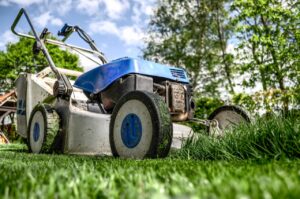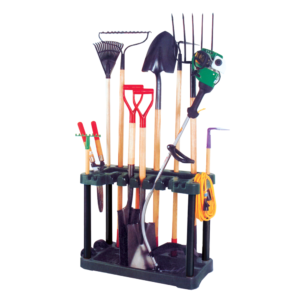Winter: Coming to Your Town!
Winter involves more than just shoveling sidewalks so it’s best to get ahead of it so you can not only prepare yourself but also your yard. You will want your lawn, shrubs, trees, and other plantings winterized or brought inside so they can survive unfavorable conditions. Preparing and protecting your tools at the end of the season will get you into the yard and garden faster in the spring when things warm up again.
Lawns
To prepare your lawn to survive the winter, mowing, raking, aerating, and fertilizing are all important. Additionally, when mowing, slowly lower your blade week by week until you get to the recommended height for your grass type. For most grasses, 2 to 2.5 inches is the lowest you will want to go. Don’t cut more than a third of the height at your starting point on any mowing. Don’t go below the minimum safe height for your grass type or you can stress the grass too much to survive the winter. Your grass will go dormant with the first freeze.
After you get your grass to a low-stress height, you will also want to aerate and fertilize it. If you live in any area that drops lots of leaves, remember raking leaves is important because it allows sunlight to get to the grass. As tempting as it is to leave it (no pun intended), it also reduces overly moist spots and allows for air circulation. You can compost your yard waste or use it to mulch around plants that need it.

Shrubs and Other Plants
Make sure when you fertilize the lawn that you don’t fertilize your other plants and shrubs. You don’t want to stimulate growth in those when they need to be storing energy in the roots for their winter survival. Once the cold weather arrives (after the first frost), that is the time to prune out dead or damaged wood. Also, remove broken and withered growth from your perennials and trim annuals to the ground. Leaving the roots will nourish other plants nearby.
In the Garden
Remove and dispose of any plants that show signs of disease. Look for deformed leaves, sticky substances, white powder, or liquid on the leaves or under them, and brown spots with yellow discolorations. Do not compost these. Instead, completely remove them from your garden or you run the risk of spreading bacteria, fungus, viruses, or bug infestations into next year’s efforts. You can extend your current crop with row covers and mulch to survive the first few cold snaps.
Protecting More Fragile Plants
Apply 2 to 6 inches of mulch around plants leaving 1 to 2 inches clear around the base of the plant. You can put mesh around the base of plants to protect them from rodents, insects, and ice. Rose bushes and young shrubs can be protected with a burlap screen that will allow sunlight but reduce cold and wind. If you have deer, you may need additional protections for your trees and shrubs.

The Hard Stuff
Inspect your sidewalks, pathways, driveway, patio, and other hardscape items by inspecting and repairing any cracks or damage before water and ice get the chance to add to the damage. Replace or repair any edging or borders showing signs of damage. Don’t forget to check around windows and doors for cracks or damaged weather stripping. And check out any outbuildings such as sheds and campers so what you have stored in them remains safe through the cold months.
If you have lawn furniture, picnic tables, or other moveable objects, those may also need to be stored for the winter or covered to protect them from the elements. Don’t leave planters on wooden surfaces as the moisture between them can cause damage during the wetter months.
The Wet Stuff
Once you are done with watering, insulate any outdoor water spouts or spigots to prevent freezing and cracking. Fully drain and roll up any hoses and store them out of the weather. If you have a sprinkler system, you will also need to drain that and shut off the water to it. You may also need to blow out the system with a compressor unless you have a reduced pressure system. Check the owner’s manual for full details or talk to your landlord about getting it done.
Protecting your Tools
When you are done with the yard work, gather up all your hand tools and do your maintenance on them so they will be ready when spring rolls around again. Remove dirt and debris and sharpen any tools that need it. Any rust should be removed with a wire brush and steel wool. To prevent rust damage, you can apply a fine oil like WD-40 or a rust protector to all metal surfaces. Sand down any rough spots on wooden handles and protect them from moisture by applying a sealer. Plastic tools can become brittle with freezing and thawing so you may want to store them somewhere warmer. This includes your power tools because the extreme cold can damage them.

Gas Powered Tools
Drain any unused gas from mowers and trimmers or add a stabilizer. Change the oil on 4-stroke engines to keep dirt and other particles from sticking to engine parts. Seal fuel caps and disconnect spark plugs and batteries. If possible, store batteries indoors for the winter. Clean off grass residue on the underside of your mower and sharpen the blades as needed. Don’t forget rarely used tools like tillers and mulchers.
For rental properties, you may not have much you need to prepare if your landlord takes care of common areas but you will still need to pay attention to decks and patios and your own personal items. But in some rental properties, all the yard maintenance is the responsibility of the renter. Be sure to alert the landlord to any problems you find while winterizing so they can address them before the bad weather hits.
If you are looking for property to rent in the Durango area, check out The Property Manager. They can help you find a property to fits your needs.
Resources
https://greenthumbplanet.com/last-lawn-cut-before-winter/
https://www.thespruce.com/winter-tool-storage-suggestions-1398302



